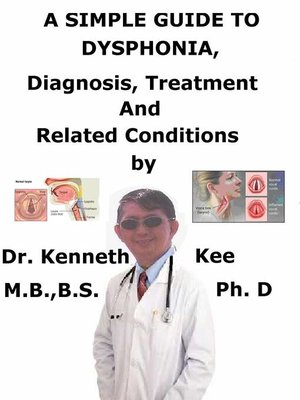
Sign up to save your library
With an OverDrive account, you can save your favorite libraries for at-a-glance information about availability. Find out more about OverDrive accounts.
Find this title in Libby, the library reading app by OverDrive.



Search for a digital library with this title
Title found at these libraries:
| Library Name | Distance |
|---|---|
| Loading... |
This book describes Dysphonia, Diagnosis and Treatment and Related Diseases
Dysphonia is a medical terminology indicating disorder of voice.
It is the impairment in the ability to produce voice sounds using the vocal (phonation) system.
It is also termed hoarseness of voice.
It is different from dysarthria which indicates dysfunction in the muscles needed to produce speech.
Dysphonia is a phonation disorder.
The dysphonic voice can be hoarse or extremely breathy, harsh, or rough, but some kind of phonation is still possible in contrast with the more serious aphonia where phonation is impossible
Alterations to the voice can happen suddenly or gradually over time.
The voice can be reported as hoarse, rough, raspy, strained, weak, breathy, or gravely.
There may be voice breaks where the voice totally stops or breaks down.
There may be pitch alterations, either higher or lower for the patient.
The patient may have a total loss of voice for duration of time as well.
Occasionally the patient will complain of pain with speaking or singing and difficulty projecting the voice.
Most often, dysphonia is produced by an abnormality with the vocal cords (also termed vocal folds) but there can be other causes from disorders with airflow from the lungs or anomalies with the structures of the throat close to the vocal cords.
In both children and adults, chronic aphonia (inability to produce voiced sound) may form which necessitates medical attention in order to diagnose what is causing this.
When dysphonia happens, rest is normally advised, but if the disorder lasts more than two weeks, a doctor should be seen to exclude the presence of any serious injury and to prevent dysphonia from developing into chronic aphonia, leading to a total loss of voice.
When dysphonia has developed, either from overusing the voice too much or infections and viruses, rest, anti-inflammatory medicines or depending on the case, speech therapy will be required.
There are two forms of dysphonia based on duration of disease:
1. Acute dysphonia - normally self-limited and resolves with rest and symptomatic treatment.
2. Chronic dysphonia - more complex since it can have multiple causes: from tumor lesions to congenital anomalies.
Types of Dysphonia
There are two general classifications or types of dysphonia.
Organic
Functional
Organic Dysphonia
The organic type involves situations where there is some sort of impediment to the function of the vocal cords, such as an infection or injury to the chords as the result of an accident.
Organic voice disorders fall into two groups:
1.Structural disorders involve something physically incorrect with the mechanism, often involving tissue or fluids of the vocal folds.
2.Neurogenic disorders are produced by a disorder in the nervous system.
Organic dysphonia may happen due to
Laryngitis (Acute: viral, bacterial) – (Chronic: smoking, GERD, LPR)
Neoplasm (Premalignant: dysplasia) – (Malignant: Squamous cell carcinoma)
Trauma (Iatrogenic: surgery, intubation) – (Accidental: blunt, penetrating, thermal)
Endocrine (Hypothyroidism, hypogonadism)
Hematological (Amyloidosis)
Iatrogenic (inhaled corticosteroids)
Functional Dysphonia
Functional dysphonia involves circumstances where there is a form of psychogenic component, or a misuse of the vocal cords.
It may be
Psychogenic
Vocal misuse
Idiopathic
Diagnosis is based on the patient's presentation and the sound of the patient's voice.
Speech therapy is the main treatment for...







